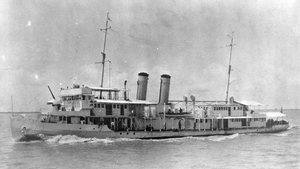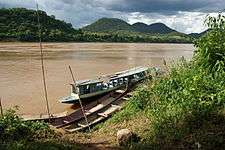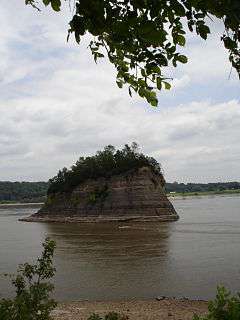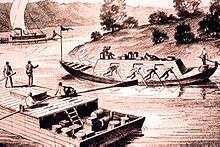River pirate

A river pirate is a type of pirate who operates along a river. The term "river piracy" has been used to describe many different kinds of pirate groups who carry out riverine attacks in Asia, Africa, Europe, North America, and South America.
Asia


.jpg)
China
In Asia, river piracy is a major threat even today. The "Yangtze Patrol", from 1854-1949, was a prolonged naval operation, protecting American treaty ports and U.S. citizens along the Yangtze River from river pirates and Chinese insurgents. During the 1860s and 1870s, American merchant ships were prominent on the lower Yangtze, operating inland up to the deepwater port of Hankou 680 mi (1,090 km). In 1874, the U.S. gunboat USS Ashuelot reached as far as Ichang, at the foot of the Yangtze gorges, 975 miles (1,569 km) from the sea. In this period, most US personnel found a tour in the Yangtze to be uneventful, as a major American shipping company had sold its interests to a Chinese firm, leaving the patrol with little to protect. The added mission of anti-piracy patrols required U.S. naval and marine landing parties to be put ashore several times in order to protect American interests.
Southeast Asia along Mekong River
Currently, in a region known as the "Golden Triangle", river piracy, combined with illegal trafficking of heroin, poses a major international law enforcement problem. One of the worst criminal cases dealing with Asian river pirates occurred on October 5, 2011, called the "Mekong River massacre". A Chinese cargo ship hauling nine hundred thousand amphetamine pills, worth more than three million dollars, was attacked and hijacked, and thirteen crewmen were killed. The hijackers were caught and executed by the Chinese government in 2012.[1][2][3]
Malaysia
Europe
Balkans
In the Balkans region, of Bosnia and Herzegovina and Croatia, the medieval Narentines, of the ninth and tenth centuries, were known for their piracy on the river Neretva.
Russia
The Ushkuiniks were medieval Russian Novgorodian river pirates from the tenth to fourteenth centuries, a Slavic version of the Vikings, through fighting, killing, and robbery. In the sixteenth-century reign of Tsar Ivan the Terrible, the legendary explorer and soldier Yermak Timofeyevich, was a Russian Cossack river pirate along the Volga or possibly Don River. Yermak was later pardoned for his crimes and became the "Conqueror of Siberia".
Along Danube River
Today, modern piracy exists on the Danube River in Serbia and Romania.
Romania

North America
United States
Ohio and Mississippi Rivers
River piracy in late eighteenth and mid-nineteenth century America was primarily concentrated along the Ohio River and Mississippi River valleys. River pirates usually operated in isolated frontier settlements, which were sparsely populated areas lacking the protection of civil authority and institutions. They resorted to a variety of tactics depending on the number of pirates and size of the boat crews involved, including deception, concealment, ambush, and assaults in open combat near natural obstacles and curiosities, such as shelter caves, islands, river narrows, rapids, swamps, and marshes. River travelers were robbed, captured, and murdered, and their livestock, slaves, cargo, and flatboats, keelboats, and rafts were sunk or sold down river.
After the Revolutionary War, American river piracy began to take root in the mid-1780s along the upper Mississippi River, between Spanish Upper Louisiana, around St. Louis and the confluence with the Ohio River at Cairo. In 1803, at Tower Rock, the U.S. Army dragoons, possibly from the frontier army post up river at Fort Kaskaskia, opposite St. Louis, raided and drove out the river pirates.
Starting in the late 1790s, Stack Island became associated with river pirates and counterfeiters. In 1809, the last major river pirate activity on the upper Mississippi came to an abrupt end, when a group of flatboatmen, meeting at the head of the "Nine Mile Reach," decided to make a raid on Stack Island and wipe out the river pirates. They attacked at night, a battle ensued, and two of the boatmen and several outlaws were killed. The attackers captured nineteen other men, a fifteen-year-old boy and two women. The women and teenager were allowed to leave. The remaining outlaws are presumed to have been executed.
From 1790-1834, Cave-In-Rock was the principal outlaw lair and headquarters of river pirate activity in the Ohio River region. The notorious cave is today within the peaceful confines of Illinois's Cave-in-Rock State Park. In 1797, it was anything but peaceful, as Samuel Mason, who was initially a Revolutionary War Patriot captain in the Ohio County, Virginia militia and an associate judge and squire in Kentucky, led a gang of highway robbers and river pirates on the Ohio. Mason started his criminal organization in Red Banks and was driven out by regulators sweeping through western Kentucky, so set up his new operation at Diamond Island, followed by Cave-In-Rock and later, along the Mississippi River, from Stack Island to Natchez, Mississippi.


During Samuel Mason's 1797-1799 occupation of Cave-In-Rock and after his departure, the name of Bully Wilson became associated with cave; a large sign was erected near the natural landmark's entrance, "Liquor Vault and House for Entertainment." Wilson may have been an alias for Mason, a front man for his criminal operation, or another outlaw leader who ran a gang of pirates in the region. The Harpe Brothers, who were allegedly America's first serial killers, were highwaymen on the run from the law in Tennessee and Kentucky, and briefly joined Samuel Mason's gang at Cave-In-Rock. Peter Alston, the son of counterfeiter Philip Alston, became a river pirate and highwayman at Cave-In-Rock and made the acquaintance of Samuel Mason and Wiley Harpe, following them to Stack Island and Natchez.
From the late 1700s to early 1800s, on the Illinois side of the Ohio River north of Cave-In-Rock, Jonathan Brown led a small gang of river pirates at Battery Rock. The lower Ohio River country was routinely patrolled by the U.S. Army, with troops garrisoned at Fort Massac as constabulary against Native Americans, colonial raiders from Spanish Louisiana, and river outlaws in the region.
Between 1790 and 1820, the legendary Colonel Plug, also known as Colonel Fluger, ran a gang of river pirates on the Ohio River, in a cypress swamp near the mouth of the Cache River, below Cave-In-Rock and Fort Massac and just above the confluence of the Ohio and Mississippi Rivers. Plug's tactics were to sneak aboard personally, or have one of his pirates secretly go into the hull of a boat, and dig out the caulking between the floor planks or drill holes with an auger, causing the boat to sink and be easily attacked. The boat and the cargo would later be sold down river.

James Ford, a civic leader and businessman, secretly led a gang of river pirates and highwaymen from the 1820s to the mid-1830s on the Ohio River, in Illinois and Kentucky.
River piracy continued on the lower Mississippi River from the early 1800s to the 1840s. These river pirates were mainly organized into large gangs similar to Samuel Mason's around Cave-In-Rock, or smaller gangs under the operation of John A. Murrell, which also existed from the 1820s to the mid-1830s between Stack Island and Natchez, Mississippi.
The decline of American river piracy occurred over time, starting as early as 1804 and ending by the 1840s, as a result of direct military action taken and the combined strength of local law enforcement and regulator-vigilante groups that uprooted and swept out pockets of outlaw resistance.
See also
References
- ↑ Rodgers, pg. 44-47
- ↑ "River Pirates of Cave-in-Rock". niu.edu. Retrieved 24 April 2015.
- ↑ "Myanmar's army recovers captured Chinese boats". townhall.com. Retrieved 24 April 2015.
